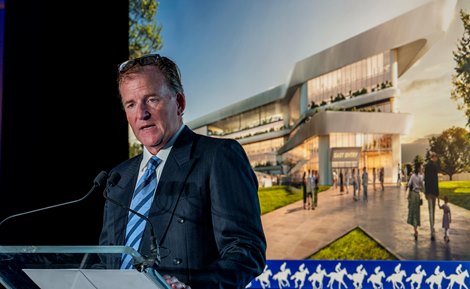Thoroughbred racing in the United States is at the forefront of a renaissance that could change substantially how existing fans engage with the sport and its effectiveness in attracting new fans.
Major renovations ongoing at Belmont Park and that have been implemented since 2014 at Churchill Downs are leading what could be an age of fan experience enlightenment for horse racing. These changes mirror a trend seen in Major League Baseball starting in 1992 with the Baltimore Orioles’ new Camden Yards ball park. That innovative project, which focused on improved food and beverage services, offered a greater variety of hospitality options and premium seating, and delivered an overall better experience, launched sweeping changes across MLB parks over the next 30 years.
“Over the same decades we have been looking at major league sports stadium and arena design, the racing industry invested heavily in technology related to simulcast wagering and gaming,” said Todd Gralla, principal/director of equestrian services for Populous, a global architectural design company, Aug. 1 during The Jockey Club Round Table Conference on Matters Pertaining to Racing held in Saratoga Springs, N.Y. “We have done a good job of integrating gaming and non-pari-mutuel sports wagering into our racing venues. But horse racing fell behind during those three or four decades related to the in-venue experience.”
Populous, then under the name HOK Sport, did the design work on Camden Yards and also worked on a major renovation of Ascot Racecourse that opened in 2006. After Ascot, Populous began working with Churchill Downs on what has been more than $400 million in facility upgrades to date and is doing the design work on Belmont Park.
“Other sports recognized more quickly that the in-venue experience was critical to sustaining fans and attracting growth in particular among younger fans,” Gralla said. “A traditionalist goes to a ball park, sits in one seat, and watches the entire game. An experientialist buys a seat but wants to roam around the ball park to see different viewing positions, different food and beverage options, and may never return to the seat purchased.
“Understanding these changes means major investments in food and beverage, comfort, premium hospitality, unique experiences, key brand partnerships and technology,” Gralla continued. “At a time when the average lifespan of an NBA arena was 20 years, the average age of our racing venues was over 60. We know from our global sports and entertainment work that people want, and will pay a premium for, intimate connections and experiences that they cannot get at home.”
The rebuilding of Belmont Park, which reopens in 2026, will create a 275,000-square-foot, five-level grandstand with seating for approximately 8,000 people. But the space includes a variety of areas with flexible configuration that can be scaled to accommodate a variety of racing and non-racing events. For example, the ground level of the grandstand and temporary overlay elements can create space for up to 50,000 guests on-site.
In addition to a variety of club and dining spaces and private suites, the redesign “unlocks” the infield and recaptures space along the stretch, which gives the New York Racing Association greater flexibility in adapting its facility to the scale of an event, such as when a horse is in contention for a Triple Crown title.
Rendering of the new Belmont Park
With renovations already bookending the racetrack hosts for the Triple Crown series, Populous is focused on a reinvention of Pimlico Race Course as well.
Gralla said he has been involved in discussions about the future of Pimlico for seven years and is now working with the newly formed Maryland Thoroughbred Racetrack Operating Authority to “determine the best strategy going forward.”
“In the past few weeks, we have found that strategy,” he said. “Unique to Pimlico is that it is a complete redevelopment, including a new track, racing operations, and the spectator facility. The site will be stripped clean after the 2025 Preakness.
“The solution will likely be similar to Belmont in that it will be scaled back but allow flexibility to scale up for the Preakness and major events,” he continued. “Our plan includes a low-stress, off-site training center to help take the pressure off the day-to-day racing facility. Design concepts to be shared soon.”
Populous is working as well with Keeneland on its largest renovation project ever. The track is relocating its administrative offices to free up space for expanded hospitality areas, new jockeys quarters, and new saddling stalls. A key element of the design is to make the renovations “look and feel like they have always been a part of Keeneland.” Gralla said this phase is the first is a series of hospitality improvements Keeneland intends to undertake.
Woodbine, Gulfstream Park, and Canterbury Park are other racetracks that have engaged Populous for design work as well as a new racecourse project in Qiddiya, Saudi Arabia, which will be the new home for the Saudi Cup (G1).
“This is our moment,” Gralla said. “We need to take the reins and urge this renaissance in racing ahead. We have people across the industry with the ambition and vision to reimagine how people experience horse racing and engage more people in this sport.”











